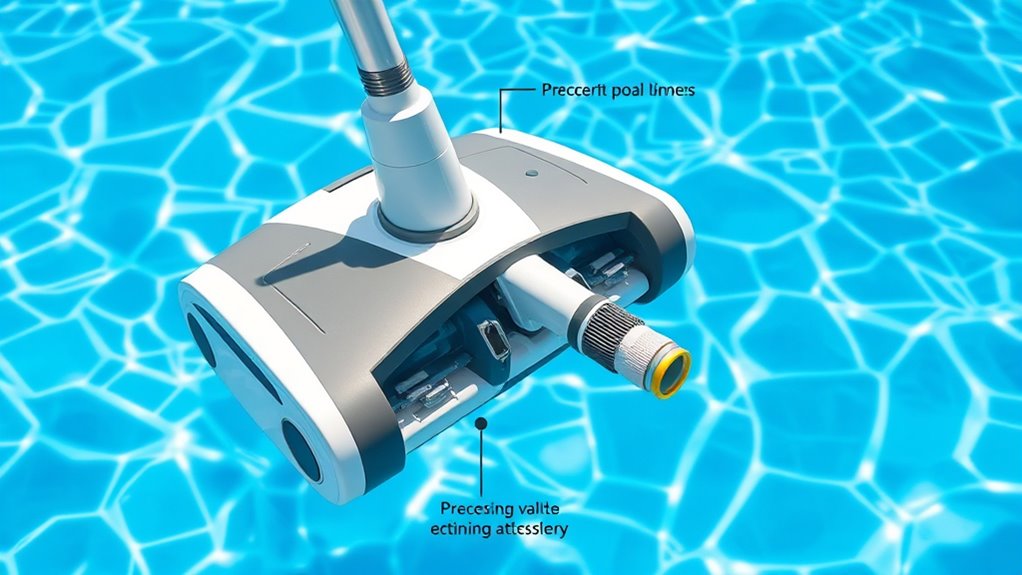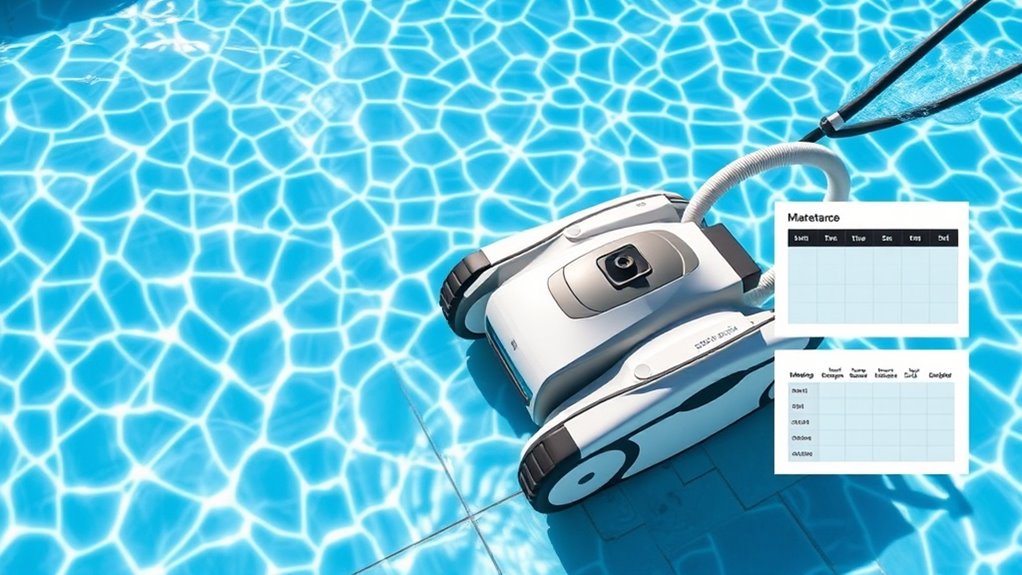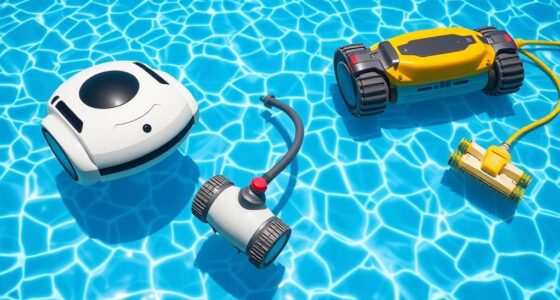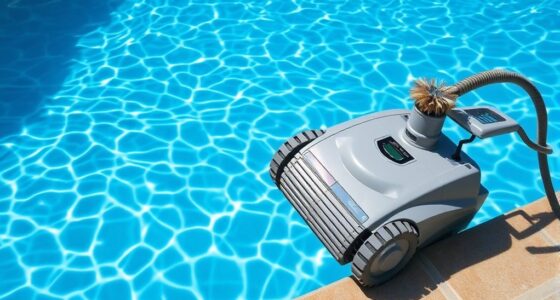To extend your suction pool cleaner’s lifespan, regularly inspect and clean its parts, like brushes, filters, and wheels, to prevent buildup and wear. Keep the water chemistry balanced and the water level correct to reduce strain on the cleaner. Use proper accessories, avoid overworking it, and store it in a dry, protected spot during off-season. Following these steps can markedly boost performance—discover more tips to keep your cleaner running smoothly.
Key Takeaways
- Regularly inspect, clean, and replace worn parts to prevent damage and maintain optimal performance.
- Maintain proper water chemistry and water levels to reduce strain and buildup on the cleaner.
- Follow manufacturer guidelines for correct usage, accessories, and seasonal storage practices.
- Schedule routine maintenance and professional servicing to address potential issues early.
- Store the cleaner in a cool, dry place, draining all water and protecting it from sunlight and chemicals.
Regularly Inspect and Clean the Cleaner Components

To keep your suction pool cleaner running smoothly, it’s essential to regularly inspect and clean its components. Establish a cleaning schedule to prevent buildup and ensure peak performance. During inspections, look for worn or damaged parts that may need component upgrades, like replacement brushes or seals. Clean the brushes, hoses, and wheels to remove debris and prevent clogs. Check the tracks or wheels for smooth operation, and remove any obstructions. Regular maintenance keeps your cleaner functioning efficiently and extends its lifespan. Upgrading components when necessary not only improves cleaning performance but also reduces the risk of costly repairs. Staying proactive with inspections and cleaning schedules safeguards your investment, ensuring your pool stays pristine with minimal downtime. Additionally, practicing regular assessments can help identify emerging issues early and maintain optimal operation. Incorporating proper maintenance techniques can further enhance the longevity of your pool cleaner and is supported by advancements in automation technology that allow for more efficient servicing. Furthermore, understanding common wear points can guide targeted maintenance efforts, reducing unexpected breakdowns.
Check and Clear the Intake and Skimmer Baskets

Make it a habit to check your intake and skimmer baskets regularly to keep your pool clean and your cleaner working efficiently. Remove debris promptly to prevent clogs and maintain proper water flow. Keeping these baskets clear helps extend the life of your suction pool cleaner. Additionally, inspecting the filter system ensures optimal performance and prevents damage to the pump.
Regular Basket Inspection
Regularly inspecting and clearing the intake and skimmer baskets prevents clogs that can hinder your pool cleaner’s performance. Check your basket filters often, especially during heavy use or storms, to ensure they aren’t full of debris. A clogged basket restricts water flow to suction ports, reducing cleaning efficiency and possibly stressing the motor. Remove leaves, dirt, and other debris from the baskets, making sure they fit properly afterward. Keep an eye on the skimmer basket and the intake filter to maintain ideal suction. Maintaining clean baskets not only helps your pool cleaner work smoothly but also extends its lifespan. Regular basket inspection is a crucial part of maintaining suction power and overall pool cleaner efficiency. Ensuring proper filter maintenance can prevent unnecessary strain on your pool cleaner’s motor and improve its longevity. Incorporate proper maintenance techniques to ensure your cleaner operates at peak performance and prolongs its lifespan. Regularly checking and replacing worn parts can also help prevent unexpected breakdowns, further protecting the investment you’ve made in your pool equipment. Make this inspection routine part of your regular pool maintenance to avoid unnecessary strain and costly repairs.
Remove Debris Promptly
Promptly removing debris from your intake and skimmer baskets keeps your pool cleaner and your cleaner working efficiently. If leaves accumulate, they can clog the baskets, reducing water flow and straining your cleaner. This can lead to increased wear and tear, shortening its lifespan. Similarly, if debris isn’t cleared quickly, algae growth may develop in the baskets, promoting algae spread in your pool. Regularly check and clear out leaves, twigs, and other debris to maintain ideal circulation. Removing debris promptly ensures your pool cleaner operates smoothly and prevents costly repairs. A clean basket also helps your pool stay clear and healthy. Incorporating proper maintenance techniques can further enhance the longevity of your suction pool cleaner. Paying attention to routine inspections can help identify potential issues early and keep your cleaner functioning at its best. Additionally, utilizing filter cleaning practices can improve overall efficiency and extend the lifespan of your equipment. Regularly inspecting the performance of your pool cleaner can also help you detect early signs of wear and address them before they cause major problems. Implementing airflow management strategies can optimize the cleaner’s operation and prevent unnecessary strain on its components.
Maintain Proper Water Chemistry Levels

You need to regularly test your pool water to make certain the chemistry stays balanced. Keeping pH and chlorine levels in the right range helps prevent buildup that can strain your cleaner. Proper water chemistry can also reduce the presence of harmful pollutants like VOCs and particulate matter, which can otherwise accumulate and affect the performance of your suction pool cleaner. When water chemistry is maintained properly, your suction pool cleaner lasts longer and works more efficiently. Additionally, maintaining proper water chemistry levels can inhibit the growth of algae and bacteria, further protecting your equipment and ensuring a safe swimming environment. Regular monitoring of water chemistry supports the electric dirt bike connection by promoting a healthier, stress-free swimming experience.
Regularly Test Water Chemistry
To keep your suction pool cleaner functioning effectively, maintaining proper water chemistry and testing the levels regularly are vital. Water testing helps you identify imbalances that can strain your cleaner and reduce its lifespan. Here are four key steps:
- Test your pool chemistry at least twice a week using accurate test kits.
- Check for pH, chlorine, alkalinity, and calcium hardness levels.
- Record your test results to track trends over time.
- Adjust chemicals as needed to maintain ideal water chemistry, preventing buildup and corrosion.
- Regular testing for water chemistry balance ensures your pool stays safe and your cleaner remains in optimal condition. Maintaining balanced water chemistry can also prevent corrosion and mineral buildup, further extending the life of your equipment.
Regular water testing ensures your pool chemistry stays balanced, which minimizes stress on your suction pool cleaner and prolongs its lifespan. Staying vigilant about water chemistry is a simple, effective way to keep your cleaner running smoothly and efficiently.
Balance Ph and Chlorine
Balancing pH and chlorine levels is essential for maintaining healthy, clear water and protecting your suction pool cleaner from damage. Proper pH balance ensures the water isn’t too acidic or alkaline, which can harm your cleaner’s components. Maintain pH levels between 7.2 and 7.6 for peak performance. Regularly test your pool’s chlorine levels to prevent algae growth and bacterial buildup; aim for 1 to 3 ppm. When chlorine levels are too high, it can cause corrosion, while low levels reduce disinfectant effectiveness. Keep a consistent testing schedule and adjust chemicals accordingly. Monitoring water chemistry is crucial for ensuring optimal pool maintenance and equipment longevity. Additionally, understanding seasonal variations can help you better anticipate changes in water chemistry and adjust your maintenance routine accordingly. By maintaining proper pH balance and chlorine levels, you not only keep your water safe and sparkling but also extend the lifespan of your suction pool cleaner. Proper water chemistry management, including chemical balance, is vital for avoiding damage to your equipment and ensuring efficient cleaning.
Ensure Correct Pool Water Level

Ensuring the pool water level is correct is essential for ideal suction cleaner performance and longevity. If the water level is too low, the cleaner won’t have proper suction, and skimmer maintenance becomes more difficult. Conversely, a high water level can cause the cleaner to lose contact with the pool surface. To keep it perfect:
Maintaining the correct water level ensures optimal cleaner performance and reduces wear on parts.
- Check the water level regularly, aiming for the middle of the skimmer opening.
- Adjust the water level by adding or removing water as needed.
- Maintain skimmer baskets to prevent blockages that affect water flow.
- Avoid overfilling or draining the pool unnecessarily, which can disrupt the suction system.
Keeping the water level in check ensures your cleaner functions efficiently and reduces unnecessary wear on its parts.
Replace Worn or Damaged Parts Promptly

Replacing worn or damaged parts promptly is essential to maintaining your suction pool cleaner’s efficiency and preventing further damage. When you notice issues like reduced suction, leaks, or unusual noises, it’s time to check for worn or broken parts. Using quality replacement parts ensures your cleaner functions at its best. Timely repairs help avoid more costly damage to the motor, hoses, or brushes. Don’t ignore signs of deterioration; addressing them early keeps your cleaner running smoothly and extends its lifespan. Regularly inspect components such as brushes, seals, and hoses, and replace any damaged items without delay. Acting quickly with replacement parts prevents dirt buildup, energy waste, and potential breakdowns, saving you money and effort in the long run.
Store Your Cleaner Properly When Not in Use

Proper storage plays a key role in maintaining your suction pool cleaner’s performance and longevity. To keep it in top shape, follow these storage tips. First, ensure your cleaner is thoroughly rinsed and dried to prevent mold and corrosion. Second, store it in a cool, dry place away from direct sunlight, which can degrade parts. Third, use the right cleaner positioning—hang it or lay it flat to avoid unnecessary stress on hoses and components. Fourth, keep the accessories organized and stored separately to prevent damage. Proper storage minimizes wear and tear, extends your cleaner’s lifespan, and guarantees it’s ready when you need it. Taking these simple steps will save you time and money while keeping your pool cleaner functioning at its best.
Use the Right Accessories and Attachments

Using the right accessories and attachments is vital for your suction pool cleaner to work efficiently. Proper accessory selection guarantees your cleaner can effectively handle your pool’s specific needs, whether it’s cleaning corners, stairs, or flat surfaces. Always check attachment compatibility to avoid damage or poor performance. Using incompatible parts can strain the motor or cause incomplete cleaning. Regularly inspect and replace worn-out brushes, hoses, and filters with compatible accessories designed for your model. Correctly fitted attachments improve suction power and maneuverability, reducing strain on the cleaner’s motor. By choosing the right accessories and ensuring they fit properly, you extend your cleaner’s lifespan and maintain excellent cleaning performance. Proper accessory management is a simple yet vital step in prolonging your suction pool cleaner’s durability.
Avoid Overworking the Cleaner

Keep an eye on how long your cleaner runs during each session, and don’t let it work nonstop. Scheduling regular breaks helps prevent motor strain and extends its lifespan. By managing cleaning cycles effectively, you guarantee your cleaner stays in great shape longer.
Monitor Cleaning Cycles
Have you noticed your suction pool cleaner running nonstop for hours? Monitoring its cleaning cycles helps prevent overworking the device. Keep an eye on how long it runs to avoid strain on components like the motor and battery. To guarantee maximum performance and longevity, consider these tips:
- Set reasonable cleaning durations based on pool size.
- Regularly check and perform filter maintenance to keep airflow smooth.
- Avoid running the cleaner when the battery is low to prevent unnecessary strain.
- Manually pause the cycle if you see it overworking or if the cleaner gets stuck.
Schedule Regular Breaks
Scheduling regular breaks for your suction pool cleaner helps prevent it from overworking and wearing out prematurely. By giving it pauses during cleaning sessions, you maintain better energy efficiency and reduce strain on its components. Breaks also improve user convenience, allowing you to monitor progress and make adjustments if needed. Overworking can lead to motor burnout and decreased lifespan. To optimize performance, consider the following:
| Break Frequency | Duration of Breaks |
|---|---|
| Every 30 minutes | 5-10 minutes |
| After covering 50% of area | 5 minutes |
| During peak sunlight | 10 minutes |
| When encountering obstacles | Short pause |
| End of cleaning session | Full stop |
Implementing scheduled breaks keeps your cleaner running smoothly longer.
Perform Routine Routine Operational Checks

Regularly performing operational checks on your suction pool cleaner guarantees it functions efficiently and lasts longer. Start by inspecting the sensor calibration to ensure the cleaner navigates properly and avoids obstacles. Next, check the power supply to confirm the connection is secure and the charger is functioning correctly. Additionally, examine the brushes and wheels for wear and tear, replacing them if necessary. Finally, verify that all hoses and connections are tight and free of debris. These simple steps can prevent minor issues from escalating, saving you money and extending your cleaner’s lifespan. Regular operational checks keep your device running smoothly, reducing downtime and ensuring your pool stays clean and inviting.
Follow Manufacturer’s Maintenance Guidelines

Following your manufacturer’s maintenance guidelines is key to keeping your suction pool cleaner in top shape. These guidelines help guarantee model compatibility with replacement parts and accessories, preventing damage caused by using incompatible components. Proper maintenance also depends on operator training; understanding how to perform routine checks and troubleshooting keeps the cleaner functioning efficiently. Regularly follow the manufacturer’s instructions for cleaning filters, inspecting hoses, and checking for wear and tear. Adhering to these guidelines minimizes unnecessary repairs and extends your cleaner’s lifespan. Remember, neglecting proper maintenance can lead to costly damage or reduced performance. By staying informed and trained on your specific model, you’ll maximize your cleaner’s durability and ensure it operates smoothly season after season.
Frequently Asked Questions
How Often Should I Replace My Suction Pool Cleaner’S Brushes?
You should replace your suction pool cleaner’s brushes during your regular maintenance schedule, typically every 4 to 6 months. Regular brush replacement ensures maximum cleaning performance and prevents damage to your pool’s surfaces. Keep an eye on the brushes for signs of wear, like fraying or missing bristles. Incorporating brush replacement into your maintenance schedule helps extend your cleaner’s lifespan and maintains effective cleaning results.
Can Using Harsh Chemicals Damage the Cleaner’S Parts?
Using harsh chemicals can cause chemical damage to your suction pool cleaner’s parts, leading to corrosion and deterioration. You should avoid strong chlorine or acid-based cleaners that can corrode sensitive components. To prevent this, rinse your cleaner thoroughly after using chemicals and opt for pool cleaning products specifically designed for equipment. Proper corrosion prevention keeps your cleaner functioning smoothly and extends its lifespan.
Is It Necessary to Calibrate My Cleaner Periodically?
You might wonder if calibration is necessary for your cleaner. Regular calibration ensures ideal calibration frequency, which helps maintain your cleaner’s accuracy. Depending on your model, you should calibrate it every few months or after major pool changes. This keeps your cleaner functioning properly, improves cleaning efficiency, and prevents misreads of the pool’s layout. By staying on top of calibration, you ensure your cleaner’s accuracy and overall performance remain high.
What Signs Indicate My Cleaner Needs Professional Servicing?
When your suction pool cleaner isn’t performing well, it’s time for professional servicing. Look for signs like unusual noises, decreased suction, or incomplete cleaning coverage. Follow your Maintenance checklist and troubleshooting tips to identify issues early. If problems persist despite these steps, a professional can inspect and repair components, ensuring your cleaner functions efficiently and lasts longer. Regular servicing keeps your pool cleaner in top shape.
How Can I Prevent Debris Buildup Inside the Cleaner’S Motor?
To prevent debris buildup inside your cleaner’s motor, focus on effective debris filtration and regular motor maintenance. Clean the filter regularly to remove trapped debris, ensuring unobstructed airflow. Check and clear any blockages in the intake and ensure the motor vents are free of debris. Performing routine maintenance, like lubricating moving parts and inspecting for wear, helps keep the motor running smoothly and extends your cleaner’s lifespan.
Conclusion
By giving your suction pool cleaner a little extra care and attention, you help it perform at its best longer. Think of it as tending a gentle garden – a few thoughtful touches can keep things thriving. With regular inspections and timely updates, you’ll enjoy sparkling water and worry-free cleaning all season. After all, a well-loved cleaner is like a trusted friend—ready to serve when you need it most, quietly ensuring your pool stays inviting and pristine.









